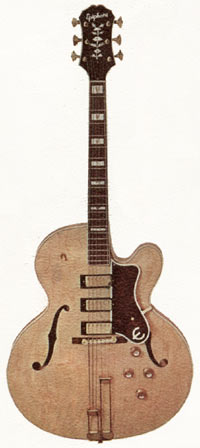
 Early 1950s Epiphone Emperor. This image comes from the 1954 Epiphone catalogue.
Early 1950s Epiphone Emperor. This image comes from the 1954 Epiphone catalogue.The Epiphone Emperor Acoustic was a very fine carved top guitar available since 1936, and produced in New York. The electric version was not launched until 1951, and represents Epiphone's Philadelphia output. The image to the left shows the example pictured in the 1954 Epiphone catalogue. Note that this has a single body cutaway. The acoustic version was available with and without the cutaway at this time.
“This superb instrument is the ultimate in electronic guitars. The Emperor has six distinctly different tonal effects derived from it's three individual pickups - all instantly produced with push-button ease! Further variations are achieved by merely adjusting the tone control - almost an unlimited choice of tone coloring! ”
It was certainly a very high end guitar, and had all the key features that would go on to define this model for decades to come: three pickups, gold-plated hardware; Frequensator tailpiece; rosewood fingerboard with pearl block inlays, inset with an abalone triangle design; and the famous Epiphone 'tree of life' headstock motif. There were two model designations, E111 (Blonde finish) and E112 (Shaded). These guitars had 1954 list prices of $535 (Blonde), or $510 (Shaded) - the acoustic versions were priced between $490 and $565.
“The Emperor laminated neck has 72 separate precision operations by Epiphone's meticulous craftsmen”
 Epiphone Emperor. This instrument is a 1966 American-made Gibson Epiphone
Epiphone Emperor. This instrument is a 1966 American-made Gibson EpiphoneThis was one of the instruments that Gibson kept in production after they bought Epiphone in 1957. The Stathopoulos-Epiphone version had quite different controls, but was otherwise quite similar to the later Gibson made model, having similar dimensions, and appointments. Gibson kept the same model designation code E112, appending it with a T indicating a thin body style, and N for a Natural (Blonde) finish.
One production was moved to Kalamazoo, the main change was the reduction in depth from a full body to a thinline. Initially they still had the old Epiphone New York pickups, although this changed to minihumbuckers in around 1961. Some early Gibson-made Emperors also had 7-piece laminated necks; Gibson bought Epiphone's entire stock of instruments and parts and used them over several years. In 1959, the name Zephyr Emperor became just Emperor and the Epiphone Zephyr became a model in its own right.
Some of the design features (inlays, hardware etc) were also used on a dual pickup double cutaway version, the Epiphone Sheraton.
Under Gibson, the Emperor was still the most expensive Epiphone guitar, and a definite flagship model. In fact in 1963 it had a US list price of $875 - exactly the same price as the Gibson Super 400 CES - only the dual pickup Johnny Smith JS-D costing more at $895/$910 depending on finish. The 1961 Epiphone catalogue describes it as Epiphone finest electric guitar, and proudest achievement. All high end models sold in small numbers, though, and by 1963, it was available by special order only, the price lists estimated a 120 day waiting time from order to delivery.
Shipping figures are not available for the Stathopoulos-era Emperor, however they are available for the 1959-68 Kalamazoo period. As can be seen, this guitar shipped in very small numbers in the 1960s - just 66 instruments over 10 years, with peak years of 1959 and 1961. Three models are listed E112T - the standard Shaded-finish Emperor, E112TN - Natural finish, and E112TH. It is unclear what precisely this H signifies.
| 1959 | 1960 | 1961 | 1962 | 1963 | 1964 | 1965 | 1966 | 1967 | 1968 | total | |
| E112TH | 7 | 7 | |||||||||
| E112T | 6 | 5 | 7 | 4 | 3 | 3 | 3 | 8 | 2 | 1 | 42 |
| E112TN | 4 | 6 | 2 | 2 | 3 | 17 | |||||
| total | 13 | 9 | 13 | 6 | 5 | 6 | 3 | 8 | 2 | 1 | 66 |
The Epiphone production moved to Japan in the 1970s, and tended to concentrate on entry and mid level guitars. The Emperor was, however, resurrected in the early 1980s, and two Japanese-made versions were offered from 1982: the full body Epiphone Emperor F, and thinline Emperor T (actually 5/16" deeper than the Gibson version at 2 1/8"). These guitars, though equipped with Epiphone-style hardware, such as the Frequensator tailpiece, bore less resemblance to the Stathopoulos-era guitars, and more to the Venetian cutaway Gibson archtops like the L-5CES, with their less narrow waist. The three pickups were reduced to two, the fretboard changed from rosewood to ebony. Although by no means a cheap guitar, the early 80s Epiphone was not in the same league as the high-end carved top electric acoustics of the 50s and 60s.
Today the Epiphone Emperor is still being produced in large numbers, with respectable Korean-made reproductions, including a Joe Pass signature model widely avilable.
$1000
$975
$8695
$1849
$2700
$2500
£3000